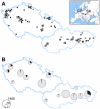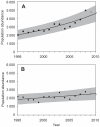Increasing incidence of Geomyces destructans fungus in bats from the Czech Republic and Slovakia
- PMID: 21079781
- PMCID: PMC2974652
- DOI: 10.1371/journal.pone.0013853
Increasing incidence of Geomyces destructans fungus in bats from the Czech Republic and Slovakia
Abstract
Background: White-nose syndrome is a disease of hibernating insectivorous bats associated with the fungus Geomyces destructans. It first appeared in North America in 2006, where over a million bats died since then. In Europe, G. destructans was first identified in France in 2009. Its distribution, infection dynamics, and effects on hibernating bats in Europe are largely unknown.
Methodology/principal findings: We screened hibernacula in the Czech Republic and Slovakia for the presence of the fungus during the winter seasons of 2008/2009 and 2009/2010. In winter 2009/2010, we found infected bats in 76 out of 98 surveyed sites, in which the majority had been previously negative. A photographic record of over 6000 hibernating bats, taken since 1994, revealed bats with fungal growths since 1995; however, the incidence of such bats increased in Myotis myotis from 2% in 2007 to 14% by 2010. Microscopic, cultivation and molecular genetic evaluations confirmed the identity of the recently sampled fungus as G. destructans, and demonstrated its continuous distribution in the studied area. At the end of the hibernation season we recorded pathologic changes in the skin of the affected bats, from which the fungus was isolated. We registered no mass mortality caused by the fungus, and the recorded population decline in the last two years of the most affected species, M. myotis, is within the population trend prediction interval.
Conclusions/significance: G. destructans was found to be widespread in the Czech Republic and Slovakia, with an epizootic incidence in bats during the most recent years. Further development of the situation urgently requires a detailed pan-European monitoring scheme.
Conflict of interest statement
Figures




References
-
- Blehert DS, Hicks AC, Behr M, Meteyer CU, Berlowski-Zier BM, et al. Bat white-nose syndrome: An emerging fungal pathogen? Science. 2009;323:227–227. - PubMed
-
- Frick WF, Pollock JF, Hicks AC, Langwig KE, Reynolds DS, et al. An emerging disease causes regional population collapse of a common North American bat species. Science. 2010;329:679–682. - PubMed
-
- Gargas A, Trest MT, Christensen M, Volk TJ, Blehert DS. Geomyces destructans sp. nov. associated with bat white-nose syndrome. Mycotaxon. 2009;108:147–154.
-
- Meteyer CU, Buckles EL, Blehert DS, Hicks AC, Green DE, et al. Histopathologic criteria to confirm white-nose syndrome in bats. J Vet Diagn Invest. 2009;21:411–414. - PubMed
-
- Courtin F, Stone WB, Risatti G, Gilbert K, Van Kruiningen HJ. Pathologic findings and liver elements in hibernating bats with white-nose syndrome. Vet Pathol. 2010;47:214–219. - PubMed
Publication types
MeSH terms
Substances
Associated data
- Actions
- Actions
- Actions
- Actions
- Actions
- Actions
- Actions
- Actions
- Actions
- Actions
- Actions
- Actions
- Actions
- Actions
- Actions
- Actions
- Actions
- Actions
- Actions
- Actions
- Actions
- Actions
- Actions
- Actions
- Actions
- Actions
- Actions
- Actions
- Actions
- Actions
- Actions
- Actions
LinkOut - more resources
Full Text Sources

